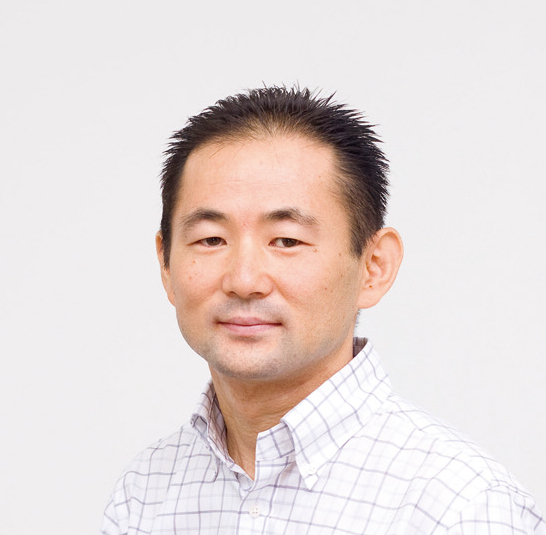Title
“What should human researchers focus on in the era of artificial intelligence and robots?”
Speaker

Taro Hitosugi
Professor
Department of Chemistry, School of Science, The University of Tokyo
School of Materials and Chemical Technology
Department of Chemical Science and Engineering, Tokyo institute of Technology
Profile:
Taro Hitosugi (English/Japanese)
Date & Venue
Abstract
Abstract [PDF]
The emergence of an "autonomous materials laboratory" using machine learning and robots is shifting a paradigm in materials science. The materials that humanity has synthesized to date represent just a tiny fraction of all possible compounds, which by some estimates may include 1060 possible materials.[1] Thus, before us lies a vast search space for new materials, many of which should be useful in addressing the problems that society faces. Therefore, materials exploration is a frontier for humanity, like space or deep-sea exploration.
Then, a question arises. How can we "quickly and systematically" find unexpected materials within this vast search space? For this purpose, materials science needs a tool that serves as a "materials explorer," like a spaceship or a deep-sea exploration vessel. There are limits on the amount and quality of research conducted when relying on human capabilities alone.
The core of the "materials explorer" is an autonomous experiment system. Here, the term autonomous means that a computer algorithm decides what experiment to do next, and robots proceed with the experiment. No human intervention is required; this approach is called closed-loop experiments [2].
When this materials explorer is shared via the internet, users can log in to this system and fabricate and evaluate materials. In addition, due to the high-throughput experiments, the system accumulates a large amount of data. Then, the data is shared with many researchers to stimulate discussions. The new system is not just about shortening time and improving efficiency but sharing data and knowledge with many researchers to obtain new materials views.
References
[1] Kirkpatrick et al., Nature 432 (2004) 823-865.
[2] Shimizu, Hitosugi et al., APL Mater. 8 (2020) 111110.
[Contact]
https://solid-state-chemistry.jp

Taro Hitosugi Professor Department of Chemistry, School of Science, The University of Tokyo School of Materials and Chemical Technology Department of Chemical Science and Engineering, Tokyo institute of Technology Profile: Taro Hitosugi (English/Japanese)
Date & Venue
Abstract
Abstract [PDF]
The emergence of an "autonomous materials laboratory" using machine learning and robots is shifting a paradigm in materials science. The materials that humanity has synthesized to date represent just a tiny fraction of all possible compounds, which by some estimates may include 1060 possible materials.[1] Thus, before us lies a vast search space for new materials, many of which should be useful in addressing the problems that society faces. Therefore, materials exploration is a frontier for humanity, like space or deep-sea exploration.
Then, a question arises. How can we "quickly and systematically" find unexpected materials within this vast search space? For this purpose, materials science needs a tool that serves as a "materials explorer," like a spaceship or a deep-sea exploration vessel. There are limits on the amount and quality of research conducted when relying on human capabilities alone.
The core of the "materials explorer" is an autonomous experiment system. Here, the term autonomous means that a computer algorithm decides what experiment to do next, and robots proceed with the experiment. No human intervention is required; this approach is called closed-loop experiments [2].
When this materials explorer is shared via the internet, users can log in to this system and fabricate and evaluate materials. In addition, due to the high-throughput experiments, the system accumulates a large amount of data. Then, the data is shared with many researchers to stimulate discussions. The new system is not just about shortening time and improving efficiency but sharing data and knowledge with many researchers to obtain new materials views.
References
[1] Kirkpatrick et al., Nature 432 (2004) 823-865.
[2] Shimizu, Hitosugi et al., APL Mater. 8 (2020) 111110.
[Contact]
https://solid-state-chemistry.jp
The emergence of an "autonomous materials laboratory" using machine learning and robots is shifting a paradigm in materials science. The materials that humanity has synthesized to date represent just a tiny fraction of all possible compounds, which by some estimates may include 1060 possible materials.[1] Thus, before us lies a vast search space for new materials, many of which should be useful in addressing the problems that society faces. Therefore, materials exploration is a frontier for humanity, like space or deep-sea exploration. Then, a question arises. How can we "quickly and systematically" find unexpected materials within this vast search space? For this purpose, materials science needs a tool that serves as a "materials explorer," like a spaceship or a deep-sea exploration vessel. There are limits on the amount and quality of research conducted when relying on human capabilities alone. The core of the "materials explorer" is an autonomous experiment system. Here, the term autonomous means that a computer algorithm decides what experiment to do next, and robots proceed with the experiment. No human intervention is required; this approach is called closed-loop experiments [2]. When this materials explorer is shared via the internet, users can log in to this system and fabricate and evaluate materials. In addition, due to the high-throughput experiments, the system accumulates a large amount of data. Then, the data is shared with many researchers to stimulate discussions. The new system is not just about shortening time and improving efficiency but sharing data and knowledge with many researchers to obtain new materials views. References [1] Kirkpatrick et al., Nature 432 (2004) 823-865. [2] Shimizu, Hitosugi et al., APL Mater. 8 (2020) 111110. [Contact] https://solid-state-chemistry.jp




